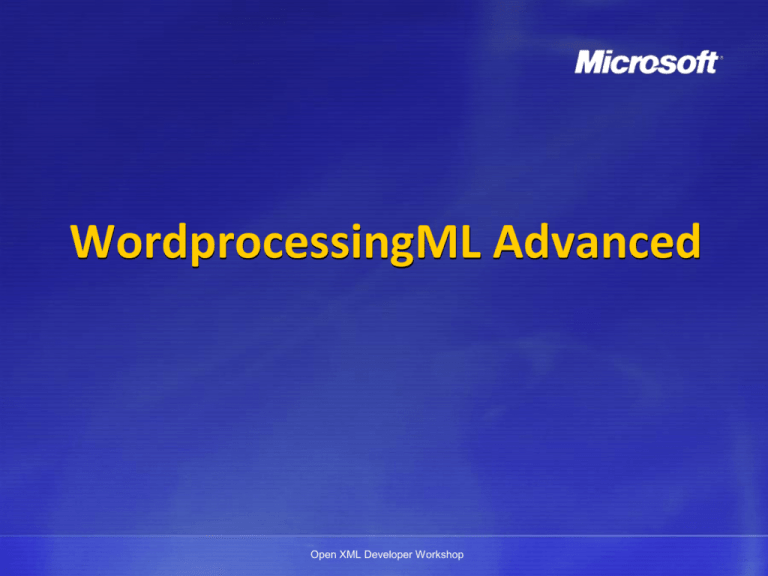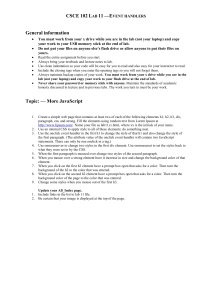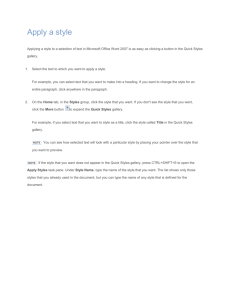
WordprocessingML Advanced
Open XML Developer Workshop
Disclaimer
The information contained in this slide deck represents the current view of Microsoft Corporation on the issues discussed as of the date of
publication. Because Microsoft must respond to changing market conditions, it should not be interpreted to be a commitment on the
part of Microsoft, and Microsoft cannot guarantee the accuracy of any information presented after the date of publication.
This slide deck is for informational purposes only. MICROSOFT MAKES NO WARRANTIES, EXPRESS, IMPLIED OR STATUTORY, AS TO THE
INFORMATION IN THIS DOCUMENT.
Complying with all applicable copyright laws is the responsibility of the user. Without limiting the rights under copyright, no part of this slide
deck may be reproduced, stored in or introduced into a retrieval system, or transmitted in any form or by any means (electronic,
mechanical, photocopying, recording, or otherwise), or for any purpose, without the express written permission of Microsoft
Corporation.
Microsoft may have patents, patent applications, trademarks, copyrights, or other intellectual property rights covering subject matter in this
slide deck. Except as expressly provided in any written license agreement from Microsoft, the furnishing of this slide deck does not give
you any license to these patents, trademarks, copyrights, or other intellectual property.
Unless otherwise noted, the example companies, organizations, products, domain names, e-mail addresses, logos, people, places and events
depicted herein are fictitious, and no association with any real company, organization, product, domain name, email address, logo,
person, place or event is intended or should be inferred.
© 2006 Microsoft Corporation. All rights reserved.
Microsoft, 2007 Microsoft Office System, .NET Framework 3.0, Visual Studio, and Windows Vista are either registered trademarks or
trademarks of Microsoft Corporation in the United States and/or other countries.
The names of actual companies and products mentioned herein may be the trademarks of their respective owners.
Open XML Developer Workshop
Objectives
This module will build on our understanding of the basics
of WordprocessingML. Topics covered include:
Styles
Stories
Glossary
Subdocuments
Document Sections
Headers/Footers
Open XML Developer Workshop
STYLES
Open XML Developer Workshop
Styles
A style defines a specific set of values for formatting
properties that may be applied as a single logical unit
For example, the Normal style in Word 2007 defines
these formatting properties:
Font = Calibri (body)
Font Size = 11 point
Font Language = Word default (as configured by user)
Justification = Left
Line Spacing = Single
Widow/Orphan control
Open XML Developer Workshop
Styles Storage
Within a WordprocessingML package, styles are stored in
a unique part
The styles part is the target of an implicit relationship
from the document part, with this relationship type:
http://schemas.openxmlformats.org/wordprocessingml/2006/styles
The styles part has this content type:
vnd-openxmlformats.officedocument.wordprocessingml-styles+xml
DEMO
Open XML Developer Workshop
Styles Storage
The styles part contains style definitions in <style>
elements:
<w:styles xmlns:w="http://schemas.openxmlformats.org/wordprocessingml/2006/main">
+ <w:docDefaults>
+ <w:latentStyles w:defLockedState="0" w:defUIPriority="99" w:defSemiHidden="1"
w:defUnhideWhenUsed="1" w:defQFormat="0" w:count="267">
+ <w:style w:type="paragraph" w:default="1" w:styleId="Normal">
+ <w:style w:type="character" w:default="1" w:styleId="DefaultParagraphFont">
+ <w:style w:type="table" w:default="1" w:styleId="TableNormal">
+ <w:style w:type="numbering" w:default="1" w:styleId="NoList">
</w:styles>
NOTE: latentStyles are not used (saved by Word but are optional)
Open XML Developer Workshop
Style Definitions
A style is defined using the style element
The style definition contains three pieces of information:
1.
Common style properties. These properties apply to all styles,
regardless of their type.
2.
The style type. Six types of styles may be defined: paragraph,
character, linked (paragraph+character), table, list (numbering), and
default.
3.
Type-specific properties. Example: cell spacing in a table style.
Open XML Developer Workshop
Common Style Properties
All style types share a set
of common properties:
Style name
Parent style on which
this style is based
Many other properties
(see §2.7)
<w:style w:type=“paragraph” w:styleId=“Heading1”>
<w:name w:val=“Heading 1”/>
<w:basedOn w:val=“Normal”/>
… other property settings …
</w:style>
Open XML Developer Workshop
Style Types
WordprocessingML supports six different types of styles:
Paragraph styles
Character styles
Linked styles
Table styles
List styles
Default style (linked type, but applies when no style specified)
Let’s look at each of these in more detail …
Open XML Developer Workshop
Paragraph Styles
Paragraph styles apply to the contents of an entire
paragraph as well as the paragraph mark
This means they can affect the paragraph properties as well as the
text formatting
They cannot be applied to sub-paragraph ranges
A paragraph style has both a set of run properties (rPr)
and paragraph properties (pPr)
The run properties are the set of properties applied to
each run in the paragraph
Open XML Developer Workshop
Paragraph Styles Example
Step 1: define a paragraph style in the styles.xml part:
<w:style w:type=“paragraph” w:styleid=“TestParagraphStyle”>
<w:name w:val=“Test Paragraph Style”/>
<w:qformat/>
<w:rsid w:val=“009E253E”/>
<w:pPr>
<w:pStyle w:val=“TestParagraphStyle”/>
<w:spacing w:line=“480” w:lineRule=“auto”/>
<w:ind w:firstLine=“1440”/>
</w:pPr>
<w:rPr>
<w:rFonts w:ascii=“Algerian” w:hAnsi=“Algerian”/>
<w:b/>
<w:color w:val=“ED1C24”>
<w:sz w:val=“40”/>
</w:rPr>
</w:style>
Open XML Developer Workshop
Common
Properties
Paragraph
Properties
Character (Run)
Properties
Paragraph Styles Example
Step 2: apply the style in the document.xml part, using the
pStyle element of the paragraph properties:
<w:p>
<w:pPr>
<w:pStyle w:val=“TestParagraphStyle”/>
</w:pPr>
<w:r>
<w:t>Text</w:t>
</w:r>
</w:p>
RESULT: the paragraph is displayed with the style applied …
Open XML Developer Workshop
Character Styles Example
Applied to runs instead of paragraphs
Can be applied to any run in the document
Can only specify run properties
can’t specify paragraph properties such as indentation
<w:style w:type=“character” w:styleId=“TestCharacterStyle”>
w:name w:val=“Test Character Style”/>
<w:priority w:val=“99”/>
<w:qformat/>
<w:rsid w:val=“00E07041”>
<w:rPr>
<w:rfonts w:ascii=“Courier New” w:hAnsi=“Courier New”/>
<w:color w:val=“FFF200”/>
<w:u w:val=“single”/>
</w:rPr>
</w:style>
Open XML Developer Workshop
Common
Properties
Character (Run)
Properties
Character Styles Example
Applying a character style to a run:
<w:r>
<w:t xml:space=“preserve”>This is some text which is of a character style</w:t>
</w:r>
<w:r w:rsidRPr=“00E07041”>
<w:rPr>
<w:rStyle w:val=“TestCharacterStyle”/>
</w:rPr>
<w:t>right here</w:t>
</w:r>
<w:r>
<w:t>.</w:t>
</w:r>
The result:
Open XML Developer Workshop
Linked Styles
Linked styles contain both a paragraph style and
character style
The two styles are connected by the link element
This tells the consumer that it should mask the fact that
these are two different styles at runtime
From the user’s point of view, the same style can be
applied to paragraphs or runs of characters
Open XML Developer Workshop
Linked Styles Example
Each style uses the link element to point to the other
style’s w:styleId value:
<w:style w:type=“paragraph” w:styleId=“TestLinkedStyle”>
<w:name w:val=“Test Linked Style”/>
<w:link w:val=“TestLinkedStyleChar”/>
<w:qformat/>
<w:rsid w:val=“00A438CE”/>
<w:pPr>
… paragraph properties are defined here …
</w:pPr>
</w:style>
<w:style w:type=“character” w:styleId=“TestLinkedStyleChar”>
<w:name w:val=“Test Linked Style Char”/>
<w:basedOn w:val=“DefaultParagraphFont”/>
<w:link w:val=“TestLinkedStyle”/>
<w:rsid w:val=“00A438CE”/>
<w:rPr>
… run properties are defined here …
</w:rPr>
</w:style>
Open XML Developer Workshop
Numbering Styles
Numbering styles are styles which define the structure of
a multi-level numbering format
Unlike other styles, numbering styles are never directly
referenced by content in the document
Instead, content (paragraphs in a list) refers to a
numbering definition instance via the numId and ilvl
elements
Numbering definition instances are based on an abstract
numbering definition
Abstract numbering definitions define paragraph
properties for up to 9 hierarchical levels
Open XML Developer Workshop
Numbering Styles
In the style part, numbering styles only have a single
property, a reference to an abstract numbering
definition:
<w:style w:type="numbering" w:styleId="TestNumberingStyle">
<w:name w:val="Test Numbering Style" />
<w:priority w:val="99" />
<w:rsid w:val="0045009F" />
<w:pPr>
<w:numPr>
<w:numId w:val="1”/>
</w:numPr>
</w:pPr>
</w:style>
The abstract numbering definition is stored in the
numbering part
Open XML Developer Workshop
Abstract Numbering Definition (abstractNum)
<w:abstractNum w:abstractNumId="0">
<w:nsid w:val="FFFFFF80" />
<w:multiLevelType w:val="singleLevel" />
<w:tmpl w:val="36EE9B9C" />
<w:lvl w:ilvl="0">
<w:start w:val="1" />
<w:numFmt w:val="bullet" />
<w:pStyle w:val="ListBullet5" />
<w:lvlText w:val=" " />
<w:lvlJc w:val="left" />
<w:pPr>
<w:tabs>
<w:tab w:val="num" w:pos="1800" />
</w:tabs>
<w:ind w:left="1800" w:hanging="360" />
</w:pPr>
<w:rPr>
<w:rFonts w:ascii="Symbol" w:hAnsi="Symbol" w:hint="default" />
</w:rPr>
</w:lvl>
</w:abstractNum>
Open XML Developer Workshop
Common
Numbering
Properties
Numbering
Levels
(up to 9)
Numbering Level Properties
Properties defined within the w:lvl element:
Starting number value
Number format code – for example, One vs. 1 vs. 1st
Restart level (which level’s presence should cause this level to restart)
Associated paragraph style
Legal numbering?
Forces the numbering from previous levels to be displayed using
Arabic numbers at this level (e.g. level 1 = ARTICLE III, level 2 = 3.1)
Numbering suffix (tab/space/nothing)
Number format text
Specifies both the static text and the level text
Syntax to specify other level text: %#; where # = level number
CONTINUED …
Open XML Developer Workshop
Numbering Level Properties (continued)
More properties defined within the w:lvl element:
Reference to an image (for picture bullets)
Number justification (left/center/right)
Paragraph properties for this level
Run properties for the numbering value itself
Level number (zero-based)
Tentative property
Specifies that the list level is currently unused and can be
redefined without changing content
Open XML Developer Workshop
Numbering Definition Instance (num)
Can be referenced by paragraphs within the document
Specifies two pieces of information:
Abstract numbering reference (abstractNumId)
Optional level overrides (lvlOverride)
May override the starting value for this level
May override the numbering for this level
<w:num w:numId=“6”>
<w:abstractNumId w:val=“4”/>
<w:lvlOverride w:ilvl=“1”>
<w:lvl w:ilvl=“1”>
<w:lvlText w:val=“%1)”/>
<w:lvlJc w:val=“left”/>
<w:pPr>
<w:ind w:left=“360” w:hanging=“360”/>
</w:pPr>
</w:lvl>
</w:lvlOverride>
</w:num>
Open XML Developer Workshop
Numbering-Style Reference
• Each numbered item is a separate paragraph
• Within numbering properties (numPr), the item is
associated with:
• A numbering definition instance (numId)
• A level within that definition (ilvl)
<w:p>
<w:pPr>
<w:numPr>
<w:ilvl w:val="0" />
<w:numId w:val="0" />
</w:numPr>
</w:pPr>
<w:r>
<w:t>this is the text for this item</w:t>
</w:r>
</w:p>
DEMO
Open XML Developer Workshop
Table Styles
Table styles supply formatting information for:
Table elements (borders, margins, shading, etc.)
Cell content (paragraph properties)
<w:style w:type="table" w:styleId="TableGrid">
<w:name w:val="Table Grid" />
<w:rsid w:val="00B07540" />
<w:pPr>
… paragraph properties …
</w:pPr>
<w:tblPr>
<w:tblInd w:w="0" w:type="dxa" />
<w:tblBorders>
… border properties …
</w:tblBorders>
<w:tblCellMar>
… cell-margin properties …
</w:tblCellMar>
</w:tblPr>
</w:style>
Open XML Developer Workshop
Paragraph
Properties
Table
Properties
Table Styles
A table style is associated with a table via the table’s tblStyle
element, which appears in the table properties
<w:tbl>
<w:tblPr>
<w:tblStyle w:val=“Style20”/>
<w:tblW w:w=“5000” w:type=“pct”/>
<w:tblLook w:val=“0220”/>
</w:tblPr>
… tblGrid, table rows and cells …
</w:tbl>
Open XML Developer Workshop
Table style Style20 is
applied to the table
Table Styles: Applying Part of a Style
The entire table style may not apply to a specific table
The tblLook element indicates which sections to apply
The value of tblLook is a hexadecimal bit mask:
0x0020=Apply first row conditional formatting
DEMO
0x0040=Apply last row conditional formatting
0x0080=Apply first column conditional formatting
0x0100=Apply last column conditional formatting
0x0200=Do not apply row banding conditional formatting
0x0400=Do not apply column banding conditional formatting
Default if tblLook is omitted = apply the entire style
Open XML Developer Workshop
Table-Section Styling Priorities
1. Top left, top right, bottom left, bottom right
2. First column, last column
3. First row, last row
4. Banded rows, even row banding
5. Banded columns, even column banding
6. Whole table
(application order is bottom to top)
Open XML Developer Workshop
Style Inheritance
Styles may inherit from other styles of the same type
(paragraph, character, table, etc.)
The basedOn element indicates the parent style
Example:
Test style inherits from …
Heading 1 style, which inherits from …
Normal style
Open XML Developer Workshop
What if we have no Style?
Document default settings are stored in the styles
part, within the docDefaults element
In previous versions of Word, these were hard-coded
and could not be changed
<w:docDefaults>
<w:rPrDefault>
<w:rPr>
… default run properties …
</w:rPr>
</w:rPrDefault>
<w:pPrDefault>
<w:pPr>
… default paragraph properties …
</w:pPr>
</w:pPrDefault>
</w:docDefaults>
Open XML Developer Workshop
Style Inheritance
How can we determine which settings will be applied?
• Start from the document defaults
• Trace the style-inheritance hierarchy
• At each level, any property settings override settings
from the basedOn styles above it
• When Word saves a document, only properties that do
not match their inherited values (i.e., overridden) are
saved.
Open XML Developer Workshop
Style Application: top-down order
Table
Characters
Paragraph
List Item
Document Defaults
Table
Numbering
Paragraph
Character
Direct Formatting
Open XML Developer Workshop
Latent Styles
The other piece of style information stored in the
document
Stores properties about styles without saving the actual
style in the file
Needed because the document may not have access to
its template
Latent style properties:
Style lockdown (can style be used?)
UI sorting priority
Use as top-level format
Unhide when used
STORIES
Open XML Developer Workshop
Stories
WordprocessingML documents have many stories:
The main story
Header(s) / Footer(s)
Footnote(s) / Endnote(s)
Subdocuments
Comment(s)
Each story is defined by two things:
It is a unique region containing block-level content
All stories share the same set of properties (styles, numbering
definitions, settings)
Exception: the Glossary document has its own properties
Open XML Developer Workshop
Glossary Document
The glossary document stores supplementary document
content: rich document content which travels with the
document to be accessible, but is not displayed
Example: AutoText entries are stored in the glossary
Unlike all other document stories, the glossary uses its
own set of styles, numbering, comments, etc.
It is essentially a separate document within a
WordprocessingML package
Open XML Developer Workshop
Glossary Document Structure
The glossary contains a set of docPart items
Any block-level content may be included in a docPart
<w:docParts>
<w:docPart>
<w:docPartPr>
… properties: name, category, guid, type, behavior …
</w:docPartPr>
… content for this glossary entry (document part) …
</w:docPart>
<w:docPart>
<w:docPartPr>
… properties: name, category, guid, type, behavior …
</w:docPartPr>
… content for this glossary entry (document part) …
</w:docPart>
</w:docParts>
Open XML Developer Workshop
Glossary Document Entries
Each entry in the glossary document consists of two
components:
The entry’s properties
The entry’s contents
The first specifies information about the entry (e.g. its
classification) for when it is inserted, the latter stores the
block level content which constitutes the entry
The glossary document also has separate copies of all the
relationships that the main document has
Its own styles, numbering, fonts, comments, headers, footers, etc.
Open XML Developer Workshop
SUBDOCUMENTS
Open XML Developer Workshop
Subdocuments
Subdocuments provide a way for a single document to
be divided into parts
These parts are each full documents and can be edited and
manipulated independently
Subdocuments don’t know they’re part of something bigger – they’re
just stand-alone documents
Master
Document
Subdocument
Subdocument
Open XML Developer Workshop
Subdocument
Subdocuments: how it works
Main document part contains subDoc elements that
indicate where to insert subdocuments
The subdocument’s location is stored in a relationship
Master
Document
Document.xml:
<w:body>
<w:subDoc r:id=“rId1”/>
<w:subDoc r:id=“rId2”/>
<w:subDoc r:id=“rId3”/>
Part1.docx
Part2.docx
Part3.docx
Document.xml.rels:
<Relationship Id=“rId1” Type=“…/subDocument” Target=“Part1.docx” TargetMode=“external”/>
<Relationship Id=“rId2” Type=“…/subDocument” Target=“Part2.docx” TargetMode=“external”/>
<Relationship Id=“rId3” Type=“…/subDocument” Target=“Part3.docx” TargetMode=“external”/>
DEMO
Open XML Developer Workshop
SECTIONS
Open XML Developer Workshop
Document Sections
A document may be divided into sections
These allow grouping at a higher level than paragraphs
Vary landscape/portrait orientation, margins or other settings
Each section has a sectPr element (inside pPr) where
properties may be defined for that section:
<w:sectPr>
<w:pgSz w:w="12240" w:h="15840"/>
<w:pgMar w:top="1440" w:right="1800" w:bottom="1440“ w:left="1800“
w:header="720" w:footer="720" w:gutter="0"/>
<w:cols w:space="720"/>
<w:docGrid w:linePitch="360"/>
</w:sectPr>
Open XML Developer Workshop
Section Breaks
Sections are defined in two ways:
1. Insertion of a section break – a section break is a
paragraph mark which also delimits a section
2. The last paragraph in the document – the final
paragraph is always a section break
• Every document has at least one section
Open XML Developer Workshop
Section Breaks = <sectPr>
Occurs in paragraph properties, within a paragraph
Properties refer to content that comes before them
Open XML Developer Workshop
Section Properties
Each section has its own settings
for the properties exposed in
Word’s Page Setup dialog
<w:sectPr>
<w:pgSz w:w="12240" w:h="15840" />
<w:pgMar w:top="1440" w:right="1440" w:bottom="1440" w:left="1440"
w:header="720" w:footer="720" w:gutter="0" />
<w:cols w:space="720" />
<w:docGrid w:linePitch="360" />
</w:sectPr>
Open XML Developer Workshop
Section Break Types
Four types of section breaks:
Next page (start on next page) -- default type
Even (start on next even page)
<w:type w:val=“evenPage”>
Odd (start on next odd page)
<w:type w:val=“oddPage”>
Continuous (starts on next paragraph)
<w:type w:val=“continuous”>
(since a continuous section break doesn’t end a page, it may not
specify page-level properties)
Open XML Developer Workshop
Final Section Properties
• The <sectPr> element always occurs inside the last
paragraph of the section, with one exception
• The final set of section properties is the final element
inside the <body>, at the same level as paragraphs
• The entire document must have section properties, and
this architecture enables enforcement of that
DEMO
requirement via XML Schema
Open XML Developer Workshop
HEADERS/FOOTERS
Open XML Developer Workshop
Headers and Footers
Headers and footers are stories in a WordprocessingML
document
Like the main document story, they can contain text,
graphics or data fields (page number, date, document
title, etc.) – any block-level content
Headers/footers are anchored to Sections
Each section may have up to three headers or footers
defined:
First-page
Odd-numbered pages (default)
Even-numbered pages
Open XML Developer Workshop
Using a Header or Footer
Each header or footer is stored in its own part
E.g., header1.xml/footer1.xml
Header main element = hdr
Footer main element = ftr
The main document has relationships to these parts:
Defined in _rels (document.xml.rels)
Referenced in the body of the document, within section properties
(sectPr) elements:
w:headerReference = header part
w:footerReference = footer part
DEMO
Open XML Developer Workshop
Open XML Developer Workshop





